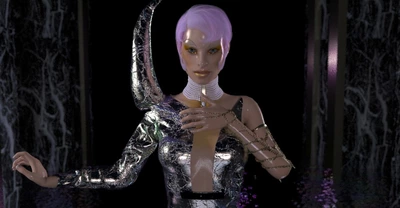
Please install a more recent version of your browser.
29 September 2020
6 minutes read
Patrick McDowell
How will fashion weeks look in the future? With the new technological possibilities, are we moving towards all-digital shows that will replace the physical events? Or will 3D fashion take its new independent niche in the fashion industry?
"The most prominent benefit of a digital space is that it allows us to set new practices and define new normality, also endorsing change. Evolution will be faster, and information and feedback can be collected more easily and seamlessly."
Evelyn Mora is a Finnish entrepreneur, strategist and sustainability consultant, based in Paris. She is also the founder of the Helsinki Fashion Week. Most recently, she founded Digital Village, a platform where all digital asset, buying, selling, trading, showing and networking are interlinked.
The year 2020 commemorates Helsinki Fashion Week’s sixth year. And while just about every other event across the planet has either had to reschedule, cancel, or come up with an alternative solution; we are privileged to be able to continue to push forward with the mission of all-things-sustainable without compromise, thanks to our partners, designers and artists involved.

Tess Van Zalinge ‘Patchwork’ digitized for Digital Village
Long before the COVID-19 pandemic hit the entire world we at Helsinki Fashion Week had already invented the ‘Designer Residency’ concept: we planned to globally broadcast behind the scenes of HFW designers' creative design processes. So this season, over 80 shows were livestreamed via Twitch together with the 3D designers, who work specifically on designing 3D clothes, and selected mentors reaching over half a million viewers in one week.
Apart from Designer Residency, for the 2020 edition, we had planned to execute the IRL showroom in 3D showcasing digital garments as in physical clothes, in a physical showroom in Helsinki, Finland. And this was the inspiration for the event to go entirely digital, in all of the meaning of the word.

Nicole Zisman

Bluehemia
“Just like a traditional atelier would do, we sew everything together starting from the patterns provided to us by the designers. We made sure that the looks are identical to the upcoming physical collections by digitally tailoring every single detail from the topstitches to the textures and buttons.” – Caroline Dussuel, Co-Founder at Scotomalab
This season, we showcased the first ever 3D fashion week in the world.
The traditional designers that were selected to showcase at the event were now given the option to keep their spot and show digitally for the first time in their careers. Starting September 2020, the Digital Village - the new separate digital platform hosted the 3D fashion week of Helsinki Fashion Week - will also be open to all the global fashion weeks to join to feature their designers digitally and create their own digital universes. The submission is now open until 30th of September and anyone interested can now apply through the website of Digital Village.
Continuing our mission and focusing on sustainability from the start, we are becoming responsible in cyberspace, exploring digital sustainability and taking into consideration the opportunities and threats that large-scale automation presents as well as aspects affecting the mental and physical health. In 2020 Helsinki Fashion Week is partnering with Normative, a company that audits sustainability data and other tech partners to audit the activity of the event to set data and fact-based targets for the rest of the industry. Take a look at the digital sustainabilty report.
The Digital Village space was designed by a selected few multidisciplinary visionaries, including information architects like Peter Morville, a pioneer of the fields of information architecture and user experience.
Through the several cross-industry environments in the Digital Village, users also have the opportunity to maintain their Digital Sanctuaries: private digital spaces where you can grow your own avatar and where the Stimulator which is the ‘fetus’ of your digital twin which can be grown and nurtured by your own voice and input. Data will be fed into the ‘fetus’ turning it into your own personal chatbot, and on a later stage, it can adapt your voice, your facial features and your personality.
We need to understand that we are working with real humans and not robots, even when the platform is completely digital.
The Sanctuary environment embraces the effects of frequencies for the human wellbeing connecting colors, movements and duration factor to create the most harmonious environment for the Users. The entire Sanctuary is brought to life by Solarflare studios.
The main aspect we learned was the importance of taking into consideration the sustainability aspects of creating digital environments just like in the physical environment. We learned about the importance of combinations when it comes to tech solutions but most importantly the entire user experience and the quality of content and curation.

Stacie Ant aka. Whosthereplease for Helsinki Fashion Week
When I first got the idea of entering a cyberworld, I instantly got in touch with Paola Pinna, a digital multidisciplinary 3D artist, who ended up creating @Kimi4Kawai, my digital twin.
I provided her photographic references of my face from different angles. The first two weeks were spent mostly to model the 3D humanoid accordingly to my real features. The second part was much more about tweaking things around and sculpting to make the avatar’s face look as similar to mine as possible.
The most challenging part of creating a digital twin was to catch the person’s energy and finest facial expressions that make it unique.
In the new editions, we will make Digital Village accessible to all users in the form of their digital avatars, basically our digital identities that will allow us to be mindful and transparent of our own digital footprint thereby enabling more conscious action. On the platform, the users will also have the opportunity to use their avatars for networking purposes, for accessing the platform in 2D, 3D, Augmented Reality or Virtual Reality mode.
We can benefit from incorporating the avatars of our users and the garments of our designers into the blockchain - by doing that, we are giving these digital items an identity, a ‘digital passport’ of a sort. This year, every user joining DigitalVillage.io had an opportunity to create a fully owned, pseudonymous, and decentralized blockchain profile. With that approach, any product, service, or information can be openly and transparently traced on the Digital Village Network. All interactions and ownership inherently attached to a product’s identity are accessible by anyone, from the creation onwards, all along its lifecycle.
In the Digital Village, Users have the opportunity to wear the clothes in cyberspace, pre-order the looks in real life and finally to claim a digital item on the blockchain - use it, trade it, and exchange, or purchase the entire source file to export the asset into other platforms like games or recreate and resell on the Digital Village platform.

Digital twins of Evelyn Mora and Japanese digital influencer Ruby Gloom
After this year’s edition, we understand that it’s hard to compare digital and physical events, and maybe we should not do it at all. We believe that each ‘realm’ of virtual or physical has its own specific strengths and weaknesses. The key is to make the best of each realm in its own way.
The answer is ‘phygital’. Digital and physical are not competitors but mediums that support each other!
We want the Digital Village to give its users a sense of accomplishment where the entire experience of the user is being designed for the benefit of the user, like a ‘circular social system’. The Digital Village does not prioritize monetary value over the value of the user’s sustainable experience and wellbeing. Instead, the platform approaches monetary value as a tool to further empower its users to create collective prosperity.
Our big vision behind the Digital Village is to enable a 3D social network that focuses on democratizing data and gives interdisciplinary creative individuals access to the tools they need to collaborate, show, co-learn and co-create. We are also committed to understanding how our physical and mixed-reality spaces will continue to be important for the wellbeing of individuals, society, and the planet as a whole.
When we work in these virtual environments, we will also have a greater reach, and there can be more variation. But the physical space has more permanence and more of an anchoring effect.
If we try to take the best lesson out of our experience this year and share it with the rest of the industry, I think that it’s the fact that it is important to keep the physical separate from the digital. There are elements to apply from real life to the digital world and vice versa to upgrade the experiences, but they are not in the position to replace one another.
We will not allow digital fashion to inherit the challenges of the IRL fashion industry, instead we will collaborate to improve the traditional fashion industry by using the digital tools. The main challenge we are still facing in the fashion industry is still the same - lack of collaboration. So my question to you is: how can we fix that?
Cookies saved